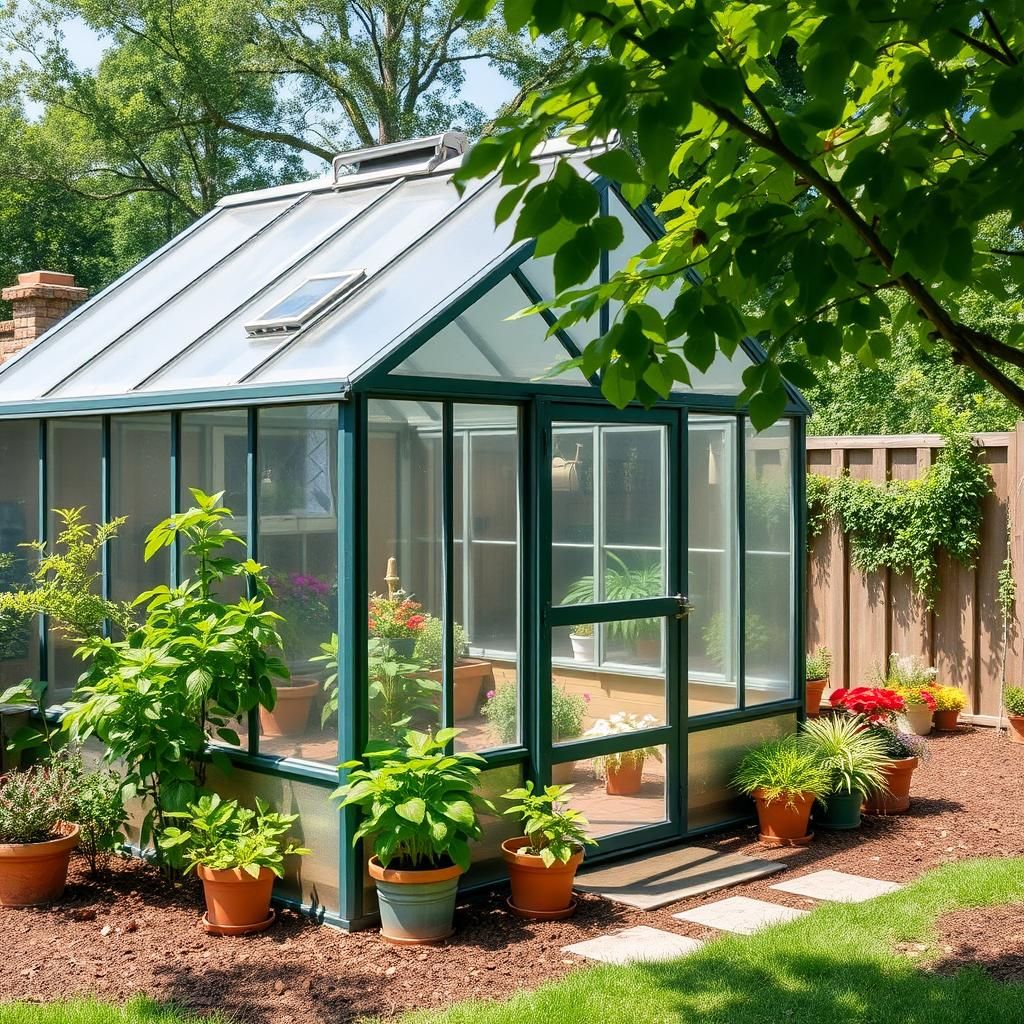Where is the Best Place to Put a Greenhouse in Your Backyard? Top Tips for Optimal Location

Choosing the right location for a greenhouse in your backyard is crucial for successful gardening. The placement affects not only the amount of sunlight your plants receive but also their overall health and productivity. Factors such as shade from trees or buildings, wind exposure, and accessibility to water sources must be considered. In this article, we will explore top tips for determining the optimal location for your greenhouse, ensuring that your plants thrive throughout the growing season. Whether you're a seasoned gardener or a beginner, finding the perfect spot can make all the difference in your gardening experience.
Optimal Locations for Your Backyard Greenhouse
Placing a greenhouse in your backyard requires careful consideration of various factors to ensure optimal growth conditions for your plants. The best spot should receive adequate sunlight, preferably with unobstructed light for most of the day, typically facing south or southeast to maximize exposure. Additionally, consider the proximity to water sources for easy irrigation, good drainage to avoid water accumulation, and protection from harsh winds and extreme weather, which can be achieved by situating it near a windbreak, such as trees or fencing. Accessibility for maintenance and the potential impact on garden aesthetics should also be considered to ensure your greenhouse integrates well with your overall backyard landscape.
Sunlight Exposure
Ensuring your greenhouse receives the right amount of sunlight is crucial for the health of your plants. Ideally, it should be located in a spot that receives full sunlight for at least six to eight hours each day. Positioning your greenhouse away from any surrounding obstructions, such as tall trees, fences, or other buildings, is essential to avoid shade that could hinder plant photosynthesis.
Wind Protection
Strong winds can negatively affect a greenhouse, leading to fluctuations in temperature and humidity and potentially damaging the structure itself. It's wise to place your greenhouse near natural windbreaks such as trees or shrubs, or construct a fence to shield it from prevalent winds. This ensures a more stable environment inside, allowing for better growth conditions.
Access to Water
It is vital to have easy access to a water source when placing your greenhouse. Proximity to a garden hose, rainwater collection system, or other irrigation methods can facilitate regular watering of your plants. This not only saves time but also encourages a more consistent and effective watering routine, essential for maintaining plant health.
See also:
Drainage Considerations
Proper drainage is a key factor to consider when deciding where to place your greenhouse, as standing water can lead to root rot and other plant diseases. Choosing a location with well-draining soil is advisable, and grading the area around the greenhouse can help ensure that any excess water flows away from the structure. If drainage is a concern, consider incorporating gravel or a more structured drainage system.
Distance From Other Plants
Positioning your greenhouse too close to other plants can create competition for resources and may lead to pest issues. Ideally, it should be at least a few feet away from existing garden beds, allowing for airflow and minimizing the risk of disease transfer. Furthermore, having space around the greenhouse provides room for maintenance and allows for easy access to surrounding areas.
| Factor | Importance | Recommendations |
|---|---|---|
| Sunlight Exposure | Critical for plant growth | South or southeast facing |
| Wind Protection | Prevents damage and temperature fluctuations | Near trees or fences |
| Access to Water | Facilitates proper irrigation | Near a hose or irrigation system |
| Drainage | Avoids root rot and diseases | Well-draining soil, graded area |
| Distance From Other Plants | Reduces competition and disease spread | A few feet away from other beds |
Assessing Sunlight Exposure in Your Backyard
Choosing the best location for a greenhouse requires careful consideration of sunlight exposure, as optimal light conditions significantly impact plant growth. A greenhouse should preferably be placed in an area that receives abundant direct sunlight for at least six to eight hours a day, ensuring that plants have enough energy for photosynthesis. It is crucial to observe the path of the sun throughout different seasons, taking note of any shadows cast by trees, buildings, or other structures that may obstruct light. Location near the south or southwest side is often ideal, as this positioning maximizes exposure to the sun while providing shelter from harsh northern winds.
Consideration of Wind Protection
Wind can be detrimental to the health of a greenhouse and the plants within. It can cause temperature fluctuations inside the structure, which may stress plants. When selecting a site, consider placing the greenhouse near natural windbreaks such as trees, hedges, or fences. These barriers can help reduce wind speed and minimize turbulence, creating a more stable and comfortable environment for your greenhouse plants. If no natural wind protection is available, constructing an artificial barrier can be a worthwhile investment.
Proximity to Water Sources
Having a nearby water source is essential for the maintenance of a productive greenhouse. Placing your greenhouse within easy reach of hoses or irrigation systems ensures that watering your plants is a seamless task. Additionally, consider incorporating a rainwater collection system to help manage drainage and conserve resources. Having access to water not only simplifies the maintenance routine but also ensures that plants receive adequate moisture, especially during hot summer months when evaporation rates are high.
See also:
Accessibility for Maintenance
Easy access to your greenhouse is vital for ongoing maintenance tasks such as watering, pruning, and harvesting. It’s important to ensure that your chosen location allows for comfortable movement around the greenhouse. Think about the necessary tools and equipment you will often need, and make sure they can be readily transported to and from the greenhouse without hassle. A pathway leading to the greenhouse can improve ease of access, especially during wet conditions, helping to keep the area tidy and functional throughout the growing season.
Soil Quality and Drainage
The quality of soil in your chosen location is paramount for any greenhouse you establish. Evaluate the drainage capabilities of the soil to ensure it does not retain excessive moisture, which can lead to root rot and fungal diseases. If the soil is heavy and retains water, consider elevating your greenhouse or adding a drainage layer to redirect excess water away from plant roots. Additionally, testing soil fertility can guide you in preparing the earth before planting, allowing you to amend it with necessary nutrients that support optimal plant growth.
Climate Considerations
Understanding your local climate is essential when positioning your greenhouse. Different regions experience varying temperature fluctuations, humidity, and seasonal conditions, all of which can affect plant health. For example, in cooler climates, a greenhouse might benefit from reflecting heat during the day to maintain optimal warmth for plants at night. Conversely, in tropical areas, ensuring adequate ventilation and shade can prevent overheating. Tailoring the greenhouse's position and design according to your specific climate will help create the most conducive environment for plant growth.
Questions from Our Readers
Where should I place my greenhouse for optimal sunlight?
A greenhouse should ideally be placed in a location that receives full sun for at least six hours a day. This often means positioning it on the south side of your backyard to maximize solar exposure. Ensure that there are no obstructions, such as trees or tall structures, that could cast shade on the greenhouse during peak sunlight hours.
How far should a greenhouse be from my house?
It's recommended to place your greenhouse at least 10 to 20 feet away from your house to avoid any shadows and to ensure proper air circulation. Additionally, this distance helps to prevent any potential moisture or pest issues that could arise from being too close to your home.
See also:
What direction should the greenhouse face?
A greenhouse should ideally face south or southeast to capture the most sunlight throughout the day. This orientation helps to maintain a consistent temperature inside the greenhouse, benefiting plant growth by ensuring they receive plenty of natural light and warmth.
Are there any zoning restrictions for placing a greenhouse?
Yes, it's important to check for any local zoning regulations or homeowners' association guidelines that may affect the placement of your greenhouse. These regulations can dictate the size, height, and placement of your greenhouse on your property to ensure it complies with neighborhood standards and doesn’t infringe on property lines.

If you want to read more articles like Where is the Best Place to Put a Greenhouse in Your Backyard? Top Tips for Optimal Location, we recommend you check out our Greenhouse category.
Leave a Reply
Related Articles